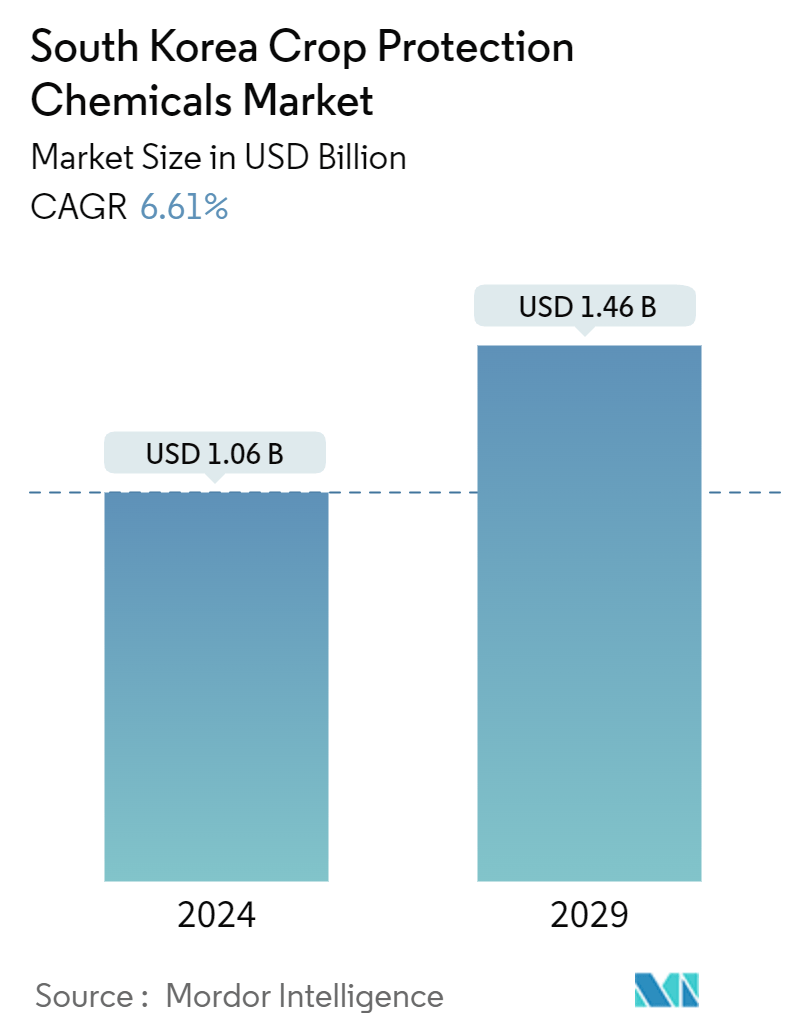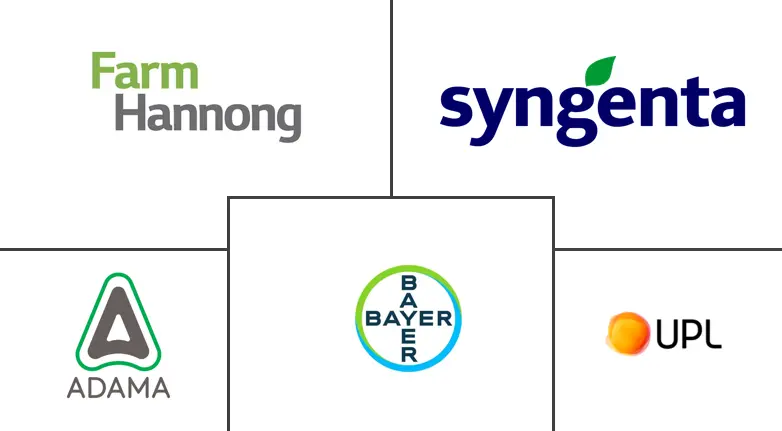Market Size of South Korea Crop Protection Chemicals Industry

| Study Period | 2019 - 2029 |
| Base Year For Estimation | 2023 |
| Market Size (2024) | USD 1.06 Billion |
| Market Size (2029) | USD 1.46 Billion |
| CAGR (2024 - 2029) | 6.61 % |
| Market Concentration | High |
Major Players
*Disclaimer: Major Players sorted in no particular order |
South Korea Crop Protection Chemicals Market Analysis
The South Korea Crop Protection Chemicals Market size is estimated at USD 1.06 billion in 2024, and is expected to reach USD 1.46 billion by 2029, at a CAGR of 6.61% during the forecast period (2024-2029).
Rice dominates South Korean agriculture, comprising about 96% of total grain production and over 40% of farm income. In 2022, South Korea produced 5.0 metric tons of rice, according to FAOSTAT. The importance of rice to the national economy and agricultural sector necessitates heavy reliance on crop protection chemicals to safeguard against pests, diseases, and weeds. Efficient use of pesticides and herbicides is crucial for maintaining high rice yields.
South Korea's mountainous terrain limits arable land to less than 22% of its total area. This scarcity pressures farmers to maximize crop productivity per unit of land. While rice is predominant, other crops such as vegetables, soybeans, oilseeds, and fruits also require significant crop protection chemicals to optimize yields on limited available land.
The South Korean government has introduced robust policies to support agricultural productivity. For instance, on 17 January 2024, the government announced a USD 230 million increase in the 2024 budget for the agricultural direct payment system, raising the total to USD 2.30 billion from USD 2.08 billion in 2023. The agricultural direct payment system incentivizes farmers to diversify crops and optimize land use. Under this system, farmers are encouraged to convert rice paddies to cultivate crops such as forage crops, vegetables (like alfalfa and clover), barley, wheat, and rye. Farmers can receive payments between USD 743 to USD 1,486 per hectare for such conversions. These payments help mitigate risks and support farmers in diversifying their production, potentially increasing the use of crop protection chemicals as they adopt new crops with different pest management requirements. With strong government support through direct payment systems and emphasis on maximizing productivity per unit area, the demand for efficient and effective crop protection solutions in South Korea is anticipaed to grow.
South Korea Crop Protection Chemicals Industry Segmentation
Crop protection chemicals constitute a class of agrochemicals used to prevent crop destruction by insect pests, diseases, weeds, and other pests. The South Korean crop protection chemicals market is segmented by chemistry (into synthetic crop protection chemicals and biopesticides), product type (into herbicides, insecticides, fungicides, and other crop protection chemicals), and crop type (into grains and cereals, pulses, and oilseeds, commercial crops, fruits, and vegetables, and other crop types). The report offers market size and forecasts in terms of value in USD and Volume in metric tons for all the above segments.
| Chemistry | |
| Synthetic Crop Protection Chemicals | |
| Biopesticides |
| Product Type | |
| Herbicides | |
| Insecticides | |
| Fungicides | |
| Other Crop Protection Chemicals |
| Crop Type | |||||
| |||||
| Pulses and Oilseeds | |||||
| |||||
| Fruits and Vegetables | |||||
| Other Crop Types |
South Korea Crop Protection Chemicals Market Size Summary
The South Korean crop protection chemicals market is poised for significant growth, driven by the country's unique agricultural landscape and regulatory environment. With rice as the dominant crop, accounting for a substantial portion of grain production and farm income, the market is characterized by a high demand for efficient crop protection solutions. The limited arable land in South Korea necessitates maximizing productivity, making crop protection chemicals essential. The market is witnessing innovation, particularly in eco-friendly and bio-based products, as companies like Adama expand their offerings to meet regulatory standards and consumer preferences. The introduction of the Positive List System (PLS) has further accelerated the adoption of biological and eco-friendly products, as it mandates strict adherence to pesticide residue safety, prompting a shift from conventional chemical pesticides to bio-pesticides.
The South Korean government's emphasis on environmental sustainability and the promotion of Environment-Friendly Agriculture (EFA) policies are reshaping the market dynamics. These policies encourage the use of registered agrochemicals and impose strict penalties for non-compliance, fostering a shift towards biological products and reducing reliance on synthetic chemicals. The increasing resistance of pests to chemical insecticides has also driven farmers towards bio-insecticides. The market is further bolstered by the growing trend of organic farming, supported by government initiatives, which have led to a notable reduction in chemical fertilizers and pesticides. The market is fairly consolidated, with major players like Syngenta, Bayer Korea Ltd, UPL Ltd, Adama Korea Co. Ltd., and Farm Hannong competing on product quality and strategic expansions to capture a larger market share.
South Korea Crop Protection Chemicals Market Size - Table of Contents
-
1. MARKET DYNAMICS
-
1.1 Market Overview
-
1.1.1 Government Support for Agricultural Productivity
-
1.1.2 Growing Agriculture Production
-
-
1.2 Rising Export Opportunities
-
1.3 Market Restraints
-
1.3.1 Environmental and Health Concern
-
1.3.2 High Costs of Input
-
-
1.4 Porter's Five Forces Analysis
-
1.4.1 Bargaining Power of Suppliers
-
1.4.2 Bargaining Power of Buyers/Consumers
-
1.4.3 Threat of New Entrants
-
1.4.4 Threat of Substitute Products
-
1.4.5 Competitive Rivalry
-
-
-
2. MARKET SEGMENTATION
-
2.1 Chemistry
-
2.1.1 Synthetic Crop Protection Chemicals
-
2.1.2 Biopesticides
-
-
2.2 Product Type
-
2.2.1 Herbicides
-
2.2.2 Insecticides
-
2.2.3 Fungicides
-
2.2.4 Other Crop Protection Chemicals
-
-
2.3 Crop Type
-
2.3.1 Grains and Cereals
-
2.3.1.1 Rice
-
2.3.1.2 Barley
-
2.3.1.3 Other Grains
-
-
2.3.2 Pulses and Oilseeds
-
2.3.3 Commercial Crops
-
2.3.3.1 Cotton
-
2.3.3.2 Other Crops
-
-
2.3.4 Fruits and Vegetables
-
2.3.5 Other Crop Types
-
-
South Korea Crop Protection Chemicals Market Size FAQs
How big is the South Korea Crop Protection Chemicals Market?
The South Korea Crop Protection Chemicals Market size is expected to reach USD 1.06 billion in 2024 and grow at a CAGR of 6.61% to reach USD 1.46 billion by 2029.
What is the current South Korea Crop Protection Chemicals Market size?
In 2024, the South Korea Crop Protection Chemicals Market size is expected to reach USD 1.06 billion.

